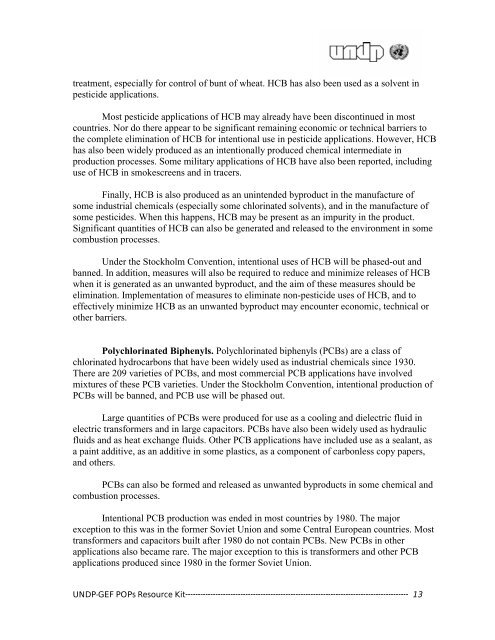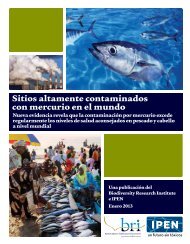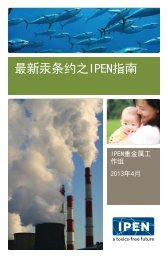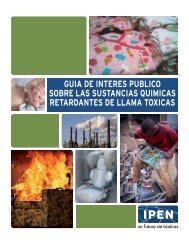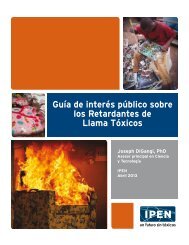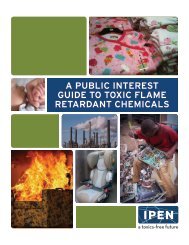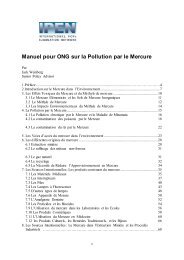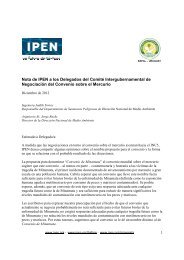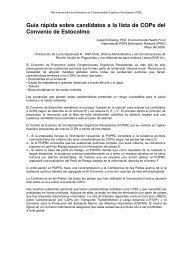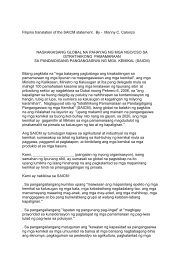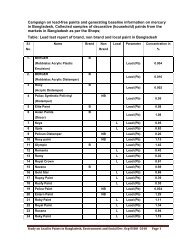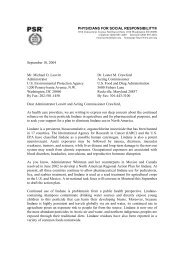The UNDP-GEF POPs Resource Kit - International POPs Elimination ...
The UNDP-GEF POPs Resource Kit - International POPs Elimination ...
The UNDP-GEF POPs Resource Kit - International POPs Elimination ...
Create successful ePaper yourself
Turn your PDF publications into a flip-book with our unique Google optimized e-Paper software.
treatment, especially for control of bunt of wheat. HCB has also been used as a solvent in<br />
pesticide applications.<br />
Most pesticide applications of HCB may already have been discontinued in most<br />
countries. Nor do there appear to be significant remaining economic or technical barriers to<br />
the complete elimination of HCB for intentional use in pesticide applications. However, HCB<br />
has also been widely produced as an intentionally produced chemical intermediate in<br />
production processes. Some military applications of HCB have also been reported, including<br />
use of HCB in smokescreens and in tracers.<br />
Finally, HCB is also produced as an unintended byproduct in the manufacture of<br />
some industrial chemicals (especially some chlorinated solvents), and in the manufacture of<br />
some pesticides. When this happens, HCB may be present as an impurity in the product.<br />
Significant quantities of HCB can also be generated and released to the environment in some<br />
combustion processes.<br />
Under the Stockholm Convention, intentional uses of HCB will be phased-out and<br />
banned. In addition, measures will also be required to reduce and minimize releases of HCB<br />
when it is generated as an unwanted byproduct, and the aim of these measures should be<br />
elimination. Implementation of measures to eliminate non-pesticide uses of HCB, and to<br />
effectively minimize HCB as an unwanted byproduct may encounter economic, technical or<br />
other barriers.<br />
Polychlorinated Biphenyls. Polychlorinated biphenyls (PCBs) are a class of<br />
chlorinated hydrocarbons that have been widely used as industrial chemicals since 1930.<br />
<strong>The</strong>re are 209 varieties of PCBs, and most commercial PCB applications have involved<br />
mixtures of these PCB varieties. Under the Stockholm Convention, intentional production of<br />
PCBs will be banned, and PCB use will be phased out.<br />
Large quantities of PCBs were produced for use as a cooling and dielectric fluid in<br />
electric transformers and in large capacitors. PCBs have also been widely used as hydraulic<br />
fluids and as heat exchange fluids. Other PCB applications have included use as a sealant, as<br />
a paint additive, as an additive in some plastics, as a component of carbonless copy papers,<br />
and others.<br />
PCBs can also be formed and released as unwanted byproducts in some chemical and<br />
combustion processes.<br />
Intentional PCB production was ended in most countries by 1980. <strong>The</strong> major<br />
exception to this was in the former Soviet Union and some Central European countries. Most<br />
transformers and capacitors built after 1980 do not contain PCBs. New PCBs in other<br />
applications also became rare. <strong>The</strong> major exception to this is transformers and other PCB<br />
applications produced since 1980 in the former Soviet Union.<br />
<strong>UNDP</strong>-<strong>GEF</strong> <strong>POPs</strong> <strong>Resource</strong> <strong>Kit</strong>----------------------------------------------------------------------------------------- 13


